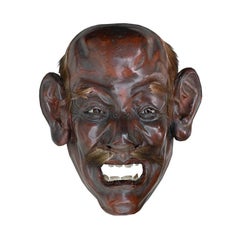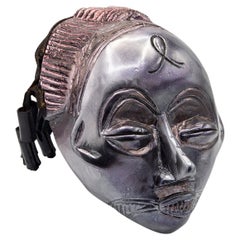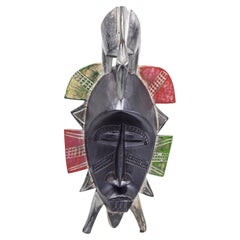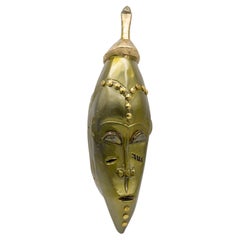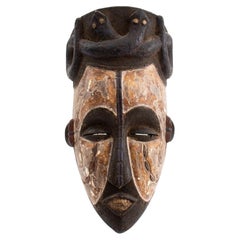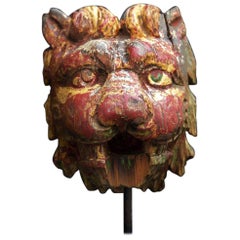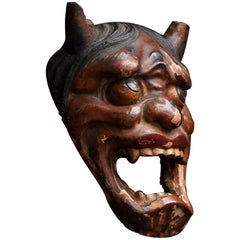Early 1900s Masks
4
to
4
4
4
4
1
8
18
224
19
50
95
27
4
3
2
6
10
23
15
3
3
4
1
3
3
1
1
1
Period: Early 1900s
19th Century Japanese Meiji Iki mask
Located in London, GB
19th Century Japanese Meiji Iki mask
A Japanese Meiji period Iki mask dated from the late 19th Century, depicting a dynamic expressive human face, with glass eyes and hair and a burn...
Category
Japanese Victorian Antique Early 1900s Masks
Materials
Gesso, Wood
Angola Chokwe Mask Revisited by Bomber Bax
Located in Milano, IT
Beautiful classic Chokwe mask genre that honours female founding ancestors. Such representations are particularly significant as the Chokwe trace the descent through the lines of their mothers. This is thought to be a dance mask with a net and wood hairstyle, from the Batshokwe people skilled in the art of carving and of very ancient origin belonging to the culture of the divine monarchy.
The Batshokwe sculptors were the most famous in the region, masters in geometric decorations such as the depiction of scarifications and tooth deformations, the surfaces of their works were carefully smoothed and polished.
On the forehead of the mask, the classic chinge-lyengelye scarification is clearly visible, commonly interpreted as a variant of the Portuguese cross...
Category
Angolan Tribal Antique Early 1900s Masks
Materials
Wood
African Futurist Black Tribal Mask by Bomber Bax
Located in Milano, IT
Contemporary African single mask created by the artist Bomber Bax.
The mask dates back to the early 1900s and was subsequently processed and painted in late 2022 by the artist.
The...
Category
Congolese Tribal Antique Early 1900s Masks
Materials
Wood
African Futurist Gold Mask Created by Bomber Bax
Located in Milano, IT
Single African mask created by artist Bomber Bax.
The mask dates back to the early 1900s and was subsequently processed and painted in late 2022 by the artist.
The artist used spec...
Category
Ivorian Tribal Antique Early 1900s Masks
Materials
Wood
Related Items
Mid-20th Century Black Dance Mask, Guerrero, Mexico
Located in Point Richmond, CA
Mid-20th century black dance mask, Guerrero, Mexico
A nice old mask from Guererro, Mexico, used in the Tlacololero Dance of the Tlactapa and probably fr...
Category
Mexican Tribal Vintage Early 1900s Masks
Materials
Wood
African Dogon Manner Tribal Face Mask
Located in New York, NY
African Dogon manner tribal face mask, in the style of the Dogon peoples of Mali.
Dimensions: 12" H x 6" W (approx)
Dealer: S138XX.
Category
Tribal Early 1900s Masks
Materials
Wood
MISTO, Seminara Ceramic Mask
Located in Paris, FR
MISTO invites itself into your interior to ward off spells, evil spirits and evil influences.
Sophie Dries reinvents the traditional Calabrian mask with her contemporary graphic
li...
Category
Italian Early 1900s Masks
Materials
Ceramic
Cariddi, Seminara Ceramic Mask
Located in Paris, FR
In Greek mythology, the name CARIDDI (Charybdis in English) belonged to a monster that lived in the sea between Calabria and Sicily and destroyed ships by swallowing them up and spitting them back out, generating dangerous whirlpools in the water. This myth is reinterpreted in the form of a mask, which inverts the traditional convex surface to create a concave volume inspired by the underwater world. The mask invites the gaze into the blue depths of its smooth interior, where an uncanny protrusion emerges in the shape of a nose, a signature motif in Giovanni De Francesco’s artistic production. Each nose-island is different from the others; every mask has a unique beauty accentuated by imperfections, smudges, and uncontrollable colors, invoking the unpredictability of fear. This perception overturns the ferocious symbolism of the legendary monster, rewriting CARIDDI as a welcoming narrative. The artist’s explorations of fear, danger, and the unknown become particularly poignant when placed in the recent historical context of Calabria and the Mediterranean Sea.
In the exceptional conditions of the present moment, when hundreds of millions of people are spending more time at home than ever before in living memory, the homeware brand TRAME wants to share the inspiring and supportive influences of these Mediterranean ritual objects with the entire world.
The masks, whether the traditional forms or the contemporary design interpretations, reveal a sense of both timelessness and contemporaneity in their aspirational evocation of a social life with more serenity and less fear.
Details:
- Dimension: approximately 28 H x 22 W x 8 D cm
- Material: 100% Mediterranean terracotta clay
- Technique: 100% handmade in Italy
- Each handcrafted CARIDDI Seminara mask is unique. Picture on an indicative basis.
- 14-days return policy
- In stock
Giovanni De Francesco (Bergamo 1976), lives and works between Milan and Paris. He is a visual artist dedicated to sculptural installations through the use of plastic materials, photography, video, painting and sound. Since 1997 he has taken part in many personal exhibits as well as collective ones. He an artistic consultant at the Luisa delle Piane gallery in Milan and is a founding member of the Monstera theatre company.
He occasionally collaborates with Andre Branzi...
Category
Italian Early 1900s Masks
Materials
Ceramic
TA RA TA TA, Seminara Ceramic Mask
Located in Paris, FR
The apotropaic (warding off evil) mask from Seminara can be distinguished by its horns, wide eyes, mustache, and screaming mouth with its tongue sticking out. The masks are finished in enormous wood fired kilns, which adds an uncontrollable twist to the features and colors rendered by the artisan’s hands—the final touch in their fierce and imperfect beauty. The demonic aspect of this mask is manifested in order to be expelled, bringing serenity to the owner and ridding the home of negative energy. Giovanni De Francesco takes an idiosyncratic approach to the traditional mask, aiming not for verisimilitude but for a rough impression of the volumes of the face. Using sculptural gestures to shape the clay, he accentuates the fundamental geometry and makes the shapes more grotesque.
Incense can also be placed within TA RA TA TA’s ceramic jaws for ritual burning. This function alludes to a specific variation of the typical mask in in the form of a chimneypot: with smoke pouring out of its mouth and eyes, the mask would appear much more ferocious—and thus even more powerful.
Details:
- Dimension: approximately 32 H x 25 W x 10 D cm
- Material: 100% Mediterranean terracotta clay
- Technique: 100% handmade in Italy
- Each handcrafted TA RA TA TA Seminara mask is unique. Picture on an indicative basis.
- 14-days return policy
- In stock
Giovanni De Francesco (Bergamo 1976), lives and works between Milan and Paris. He is a visual artist dedicated to sculptural installations through the use of plastic materials, photography, video, painting and sound. Since 1997 he has taken part in many personal exhibits as well as collective ones. He an artistic consultant at the Luisa delle Piane gallery in Milan and is a founding member of the Monstera theatre company. He occasionally collaborates with Andre Branzi...
Category
Italian Early 1900s Masks
Materials
Ceramic
100 FEARS, Seminara Ceramic Mask
Located in Paris, FR
The traditional masks of the Calabrian town of Seminara are intended to chase away evil from the home, dispel fears and gossip with their exaggerated and grotesque features. The mask...
Category
Italian Early 1900s Masks
Materials
Ceramic
African Mask, Angola, 20th Century
Located in Berlin, DE
African mask in hand painted wood, 20th century Angola.
Category
Angolan Early 1900s Masks
Materials
Wood
Old African Songye Female Kifwebe Wall Mask with Expressive Face Large Sized
Located in Torquay, GB
Large sized Songye Female Kifwebe mask from The Congo circa 1920s.
Traditionally, the Kifwebe mask is very symbolic in the Bantu culture of central Africa.
Its striking colours and carving symbolise the battle between good and evil.
Female Kifwebe masks represent femininity, the continuation of life and a good omen.
These masks were used for wedding ceremonies, reproduction rituals and other such occasions.
This large mask...
Category
Congolese Tribal Early 1900s Masks
Materials
Wood
H 13.78 in W 7.88 in D 6.7 in
Collection of Handmade Mexican Folk Art Masks
Located in Atlanta, GA
Collection of Handmade Mexican Folk Art Tin Masks, Mexican, circa 1950s. Each mask is unique and extremely detailed. The largest mask measures 21"...
Category
Mexican Folk Art Vintage Early 1900s Masks
Materials
Copper, Tin
Traditional, Seminara Ceramic Mask
Located in Paris, FR
Ditto potters with Antonio Bonamico.
The ceramic masks of Seminara are ostentatious and grotesque, with deliberately frightening features to scare away ...
Category
Italian Early 1900s Masks
Materials
Ceramic
MISTO, Seminara Ceramic Mask, Green, Sophie Dries
Located in Paris, FR
MISTO invites itself into your interior to ward off spells, evil spirits and evil influences.
Sophie Dries reinvents the traditional Calabrian mask with her contemporary graphic
li...
Category
Italian Early 1900s Masks
Materials
Ceramic
Songye Basangwe Mask DRC Wall Hanging Mask Circa 1950s
Located in Torquay, GB
On offer is a Basangwe mask from the Songye people of the Democratic Republic of Congo, circa 1950s.
The mask has the typical facial shape of the Basangwe mask.
At the top, it has a pair of stylised birds decorated with punched triangles. Their long beaks seem to suggest Hornbill or Kalao bird.
The eyes are slanted elongated slits, it has narrow nose and protruding circular mouth in a light russet colour.
It has a banded stripe design in black and white more similar to a Songye Kifwebe mask...
Category
Congolese Tribal Early 1900s Masks
Materials
Wood, Paint
Previously Available Items
Dunton of Reading Romany Gargoyle, circa 1908
Located in London, GB
Gargoyle from a Dunton of Reading Romany Living Wagon, circa 1908
Detail:
This lot is a very rare and one off handmade Folk Art traveling caravan that was built in Reading by Dunton and Sons beside the River Kennet at Crane Wharf in 1914.
This item would have been the main feature that sat above the main entrance (Crown Band)to the wagon. A true piece of English Folk Art Gypsy Caravan history, The Dunton made Romany living wagon was the Rolls Royce of travelling wagons in the 1900s, They were completely hand built and only affordable by the wealthiest of traveling families. The wagon that this item is from was restored by the late Micheal Lee who is one of the most well renowned wagon builders and restorers of his time. The Gargoyle item for sale was obtained from a private collector of English Folk Art and we have to say is the rarest item in our store.
The item sits on a black metal stand and fits perfectly onto the stand for display purposes, the Item however can be removed easily and handled. The stand is sold as part of this lot.
History
This caravan was built in Reading by Dunton and Sons beside the River Kennet at Crane Wharf in 1914.
Caravans like this were first built for travelling show people in the early 19th century. Gypsies started to live in caravans in the 1850s. Before this they had travelled by horse or foot and camped in tents. The Romany word for caravan is vardo.
Several types of caravan developed in the 19th century. This one is known as a ‘Ledge’ because the body is built out over the wheels. Dunton also built the ‘Reading’ type caravan that was very popular with the Gypsy Community as it was suited to poorly surfaced tracks. The reality of everyday life on the road for the Gypsies could be hard especially when faced with extremes of weather, and discrimination.
The romantic image of Gypsy life led some members of the middle classes to buy or hire Gypsy caravans for horse drawn holidays in the 1900s. This inspired the episode in Kenneth Graham’s The Wind in the Willows, when Mr Toad takes a short-lived caravan adventure. Kenneth Graham lived near Reading in Pangbourne.
Dunton’s are first recorded as ‘coach and cart wheelwright and general smith’ at 30 King’s Road and Highbridge Wharf in 1874. It is not known when they made their first caravan but by 1884 they were described as ‘van builders’. By 1889, as ‘coach and carriage...
Category
British Folk Art Antique Early 1900s Masks
Materials
Wood
Temple Hannya Mask
Located in London, GB
Early 20th century terracotta decorative handmade Temple Hannya mask
This lot is a wonderful example of a decorative Japanese early 20th century Temple ...
Category
Japanese Folk Art Antique Early 1900s Masks
Materials
Terracotta
